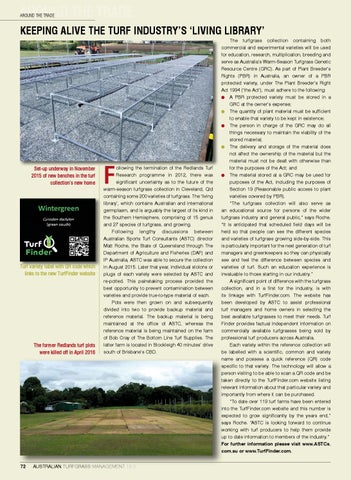AROUND THE TRADE AROUND THE TRADE
KEEPING ALIVE THE TURF INDUSTRY’S ‘LIVING LIBRARY’
Set-up underway in November 2015 of new benches in the turf collection’s new home
Turf variety label with QR code which links to the new TurfFinder website
The former Redlands turf plots were killed off in April 2016
72
F
ollowing the termination of the Redlands Turf Research programme in 2012, there was significant uncertainty as to the future of the warm-season turfgrass collection in Cleveland, Qld containing some 200 varieties of turfgrass. The ‘living library’, which contains Australian and international germplasm, and is arguably the largest of its kind in the Southern Hemisphere, comprising of 15 genus and 27 species of turfgrass, and growing. Following lengthy discussions between Australian Sports Turf Consultants (ASTC) director Matt Roche, the State of Queensland through The Department of Agriculture and Fisheries (DAF) and IP Australia, ASTC was able to secure the collection in August 2015. Later that year, individual stolons or plugs of each variety were selected by ASTC and re-potted. This painstaking process provided the best opportunity to prevent contamination between varieties and provide true-to-type material of each. Pots were then grown on and subsequently divided into two to provide backup material and reference material. The backup material is being maintained at the office of ASTC, whereas the reference material is being maintained on the farm of Bob Cray of The Bottom Line Turf Supplies. The latter farm is located in Stockleigh 40 minutes’ drive south of Brisbane’s CBD.
AUSTRALIAN TURFGRASS MANAGEMENT 18.3
The turfgrass collection containing both commercial and experimental varieties will be used for education, research, multiplication, breeding and serve as Australia’s Warm-Season Turfgrass Genetic Resource Centre (GRC). As part of Plant Breeder’s Rights (PBR) in Australia, an owner of a PBR protected variety, under The Plant Breeder’s Right Act 1994 (‘the Act’), must adhere to the following: l A PBR protected variety must be stored in a GRC at the owner’s expense; l The quantity of plant material must be sufficient to enable that variety to be kept in existence; l The person in charge of the GRC may do all things necessary to maintain the viability of the stored material; l The delivery and storage of the material does not affect the ownership of the material but the material must not be dealt with otherwise than for the purposes of the Act; and l The material stored at a GRC may be used for purposes of the Act, including the purposes of Section 19 (Reasonable public access to plant varieties covered by PBR). “The turfgrass collection will also serve as an educational source for persons of the wider turfgrass industry and general public,” says Roche. “It is anticipated that scheduled field days will be held so that people can see the different species and varieties of turfgrass growing side-by-side. This is particularly important for the next generation of turf managers and greenkeepers so they can physically see and feel the difference between species and varieties of turf. Such an education experience is invaluable to those starting in our industry.” A significant point of difference with the turfgrass collection, and in a first for the industry, is with its linkage with TurfFinder.com. The website has been developed by ASTC to assist professional turf managers and home owners in selecting the best available turfgrasses to meet their needs. Turf Finder provides factual independent information on commercially available turfgrasses being sold by professional turf producers across Australia. Each variety within the reference collection will be labelled with a scientific, common and variety name and possess a quick reference (QR) code specific to that variety. The technology will allow a person visiting to be able to scan a QR code and be taken directly to the TurfFinder.com website listing relevant information about that particular variety and importantly from where it can be purchased. “To date over 119 turf farms have been entered into the TurfFinder.com website and this number is expected to grow significantly by the years end,” says Roche. “ASTC is looking forward to continue working with turf producers to help them provide up to date information to members of the industry.” For further information please visit www.ASTCs. com.au or www.TurfFinder.com.
